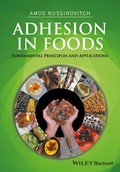Adhesion in Foods
Fundamental Principles and Applications

1. Auflage Januar 2017
240 Seiten, Hardcover
Wiley & Sons Ltd
To the layman, adhesion is a simple matter of how well two different materials stick together, and adhesion measurements provide some indication of the force required to separate them. However, a more detailed look at adhesion shows that it is a very important feature of food throughout its manufacturing, packaging and storage.
Chapters are fully devoted to the fascinating topic of adhesion in foods. Key features of the book include, but are not limited to: definition and nomenclature of adhesion; adhesion mechanisms and measurements; stickiness in various foods and its relation to technological processes; perception of stickiness; hydrocolloids as adhesive agents for foods; adhesion phenomena in coated, battered, breaded and fried foods; electrostatic adhesion in foods; multilayered adhered food products, and adhesion of substances to packaging and cookware.
Adhesion in Foods: Fundamental Principles and Applications is dedicated not only to the academic community but also to the broader population of industrialists and experimentalists who will find it to be not only a source of knowledge, but also a launching pad for novel ideas and inventions. In particular, this book is expected to be of interest to personnel involved in food formulation, food scientists, food technologists, industrial chemists and engineers, and those working in product development.
Acknowledgments xi
Outline xiii
1 Adhesion: Definition and Nomenclature 1
1.1 Introduction 1
1.2 Adhesives--a Brief Historical Viewpoint 1
1.3 Nomenclature and Definitions of Adhesion Terms 6
1.4 Concluding Remarks 11
References 12
2 Adhesion Mechanisms and Measurements 17
2.1 Introduction 17
2.2 The Phenomenon of Adhesion 17
2.3 Methods of Determining Adhesion of Food Materials 27
2.4 Adhesion Strength Measurements 29
2.5 Wettability 30
References 39
3 Stickiness of Foods and Its Relation to Technological Processes 47
3.1 Introduction 47
3.2 Dough Properties and Stickiness 47
3.3 Cookies, Breads, Cakes, and Pasta 49
3.4 Stickiness of Rice 54
3.5 Fruit Powders 57
3.6 Stickiness of Milk Powders 59
3.7 Cereal Products 60
3.8 Relations Between Technological Processes and Stickiness 61
References 65
4 Perception of Stickiness 75
4.1 Introduction 75
4.2 Collection and Classification of Words for Descriptions of Food Texture 75
4.3 Principles of Objective Measurements of Stickiness 77
4.4 The Problematic Nature of Instrumental Determinations 78
4.5 Perception of Stickiness in Oil -in -Water Dairy Emulsions 79
4.6 Stickiness of Dispersions, Semi -solids, and Sugar -rich Foods 80
4.7 Changes in Sensory Stickiness Perception with Age 84
References 88
5 Hydrocolloids as Adhesive Agents in Foods 93
5.1 Introduction 93
5.2 Food Uses and Applications of Adhesives 93
5.3 Hydrogel-Adherend Relationships and Structure-Function Issues 94
5.4 Hydrocolloid Adhesion Tests 96
5.5 Hydrocolloids as Wet Glues 98
5.6 Hydrocolloids as Adhesives in Foods 100
5.7 Hydrocolloid Adhesion: Future Prospects and Possible Developments 109
References 110
6 Adhesion Phenomena in Coated, Battered, Breaded, and Fried Foods 115
6.1 Introduction 115
6.2 A Few Definitions 115
6.3 Enrobing Processes 118
6.4 Types of Batter and Their Use in Different Products 119
6.5 Breaded Products 128
6.6 New Batters and Breadings 131
References 132
7 Electrostatic Adhesion in Foods 137
7.1 Introduction 137
7.2 Technology of Electrostatic Powder Spraying 137
7.3 Adhesion of Food Powders onto Food Products 140
7.4 Adhesion of Sodium Chloride and Its Effect on Coating 143
7.5 Other Food -Related Uses of Electrostatic Adhesion 147
References 152
8 Multilayered Adhered Food Products 159
8.1 Introduction 159
8.2 Multilayered Hydrocolloid -Based Foodstuffs 159
8.3 Stiffness and Compressive Deformabilities of Multilayered Texturized Fruits and Gels 160
8.4 Other Edible Multilayered Hydrocolloid Products 161
8.5 Layered Cellular Solids 164
8.6 Future Biotechnological Potential Uses of Multilayered Gels 165
8.7 Methods to Estimate Properties of Multilayered Products 167
8.8 Current Systems and Methods to Prepare Multilayered Products 168
8.9 Problems Related to Multilayered and Colored Products 169
References 174
9 Adhesion of Substances to Food Packages and Cookware 179
9.1 Wetting Properties of Food Packaging 179
9.2 Adhesion of Fermented Dairy Products to Packaging Materials 182
9.3 Active Food Packaging and Bacterial Adhesion 184
9.4 Antimicrobial Food Packaging 185
9.5 Protein Adsorption to Processing Surfaces 187
9.6 Adhesion of Edible Oils to Food -Contact Surfaces 188
9.7 Microorganism Adhesion to and Oil Removal from Modified Surfaces 188
9.8 Aspects of Non -stick Coatings for Cookware 190
References 192
Index 199


